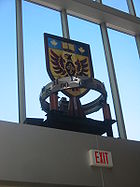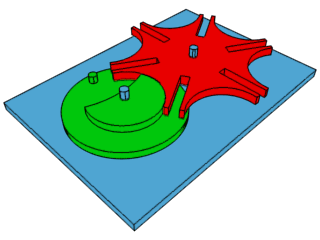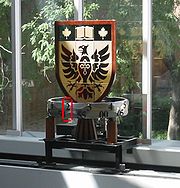
Iron Ring Clock
Encyclopedia

Mechanical engineering
Mechanical engineering is a discipline of engineering that applies the principles of physics and materials science for analysis, design, manufacturing, and maintenance of mechanical systems. It is the branch of engineering that involves the production and usage of heat and mechanical power for the...
students at McMaster University
McMaster University
McMaster University is a public research university whose main campus is located in Hamilton, Ontario, Canada. The main campus is located on of land in the residential neighbourhood of Westdale, adjacent to Hamilton's Royal Botanical Gardens...
in Hamilton, Ontario
Hamilton, Ontario
Hamilton is a port city in the Canadian province of Ontario. Conceived by George Hamilton when he purchased the Durand farm shortly after the War of 1812, Hamilton has become the centre of a densely populated and industrialized region at the west end of Lake Ontario known as the Golden Horseshoe...
, Canada. The clock
Clock
A clock is an instrument used to indicate, keep, and co-ordinate time. The word clock is derived ultimately from the Celtic words clagan and clocca meaning "bell". A silent instrument missing such a mechanism has traditionally been known as a timepiece...
was designed and built as a thesis project by Patrick Burton, Braden Kurczak, Michael Paddags, and Peter Whitred. It won the 2nd prize for Manufacturing at the 2003 Canadian Society for Mechanical Engineering Student Design Competition. The clock was simultaneously put into commission and donated to McMaster University in September 2003. The term iron ring
Iron Ring
The Iron Ring is a ring worn by many engineers in Canada as a symbol and reminder of the obligations and ethics associated with the profession. Obtaining the ring is an optional endeavour, as it is not a prerequisite to becoming a Professional Engineer...
as used here refers to a ceremonial ring worn by many Canadian engineer
Engineer
An engineer is a professional practitioner of engineering, concerned with applying scientific knowledge, mathematics and ingenuity to develop solutions for technical problems. Engineers design materials, structures, machines and systems while considering the limitations imposed by practicality,...
s, and does not specifically refer to a ring made of iron.

The clock was designed in large part in a four month period at the end of 2002, with some features which were originally intended for an outdoor installation. The clock keeps time through the use of a synchronous alternating current
Alternating current
In alternating current the movement of electric charge periodically reverses direction. In direct current , the flow of electric charge is only in one direction....
motor
Electric motor
An electric motor converts electrical energy into mechanical energy.Most electric motors operate through the interaction of magnetic fields and current-carrying conductors to generate force...
, which regulates its speed based on the frequency
Frequency
Frequency is the number of occurrences of a repeating event per unit time. It is also referred to as temporal frequency.The period is the duration of one cycle in a repeating event, so the period is the reciprocal of the frequency...
of the electricity
Electricity
Electricity is a general term encompassing a variety of phenomena resulting from the presence and flow of electric charge. These include many easily recognizable phenomena, such as lightning, static electricity, and the flow of electrical current in an electrical wire...
that it is fed. The top and bottom halves of the ring can rotate independently, with the top half of the ring displaying the hours, and the bottom half the minutes. The minute ring moves constantly, while the hour ring increments once an hour through the use of a Geneva drive
Geneva drive
The Geneva drive or Maltese cross is a gear mechanism that translates a continuous rotation into an intermittent rotary motion. The rotating drive wheel has a pin that reaches into a slot of the driven wheel advancing it by one step...
mechanism. (The mechanism used in the clock differs slightly from the one shown in the graphic as it has only 4 spokes.) The rings are driven through a gearbox which was designed and partly manufactured by the group. The two ring sections are made of forged stainless steel
Stainless steel
In metallurgy, stainless steel, also known as inox steel or inox from French "inoxydable", is defined as a steel alloy with a minimum of 10.5 or 11% chromium content by mass....
, with machined surfaces, and facets cut using a robotic six-axis water jet cutter
Water jet cutter
A water jet cutter, also known as a waterjet, is a tool capable of slicing into metal or other materials using a jet of water at high velocity and pressure, or a mixture of water and an abrasive substance. The process is essentially the same as water erosion found in nature but greatly accelerated...
. The central shield, which is the university coat of arms, is made of hand-crafted stained glass. The design of the clock was completed entirely with computer-aided design
Computer-aided design
Computer-aided design , also known as computer-aided design and drafting , is the use of computer technology for the process of design and design-documentation. Computer Aided Drafting describes the process of drafting with a computer...
software, and CNC tools were used for components where the most precision was required. Although the clock was donated to McMaster University on completion, it is maintained by members of the team that built it.
To minimise costs, the team with help from technicians manufactured as many components as possible in an on-campus machine shop. The total cost of the clock was approximately $20,000 CAD
Canadian dollar
The Canadian dollar is the currency of Canada. As of 2007, the Canadian dollar is the 7th most traded currency in the world. It is abbreviated with the dollar sign $, or C$ to distinguish it from other dollar-denominated currencies...
, which was raised through donations, with donors listed on a nearby plaque.
The team believes that the iron ring
Iron Ring
The Iron Ring is a ring worn by many engineers in Canada as a symbol and reminder of the obligations and ethics associated with the profession. Obtaining the ring is an optional endeavour, as it is not a prerequisite to becoming a Professional Engineer...
made for the project, with a diameter slightly greater than 1 metre, is the largest in the world.
Issues and Lifetime Wear

Uninterruptible power supply
An uninterruptible power supply, also uninterruptible power source, UPS or battery/flywheel backup, is an electrical apparatus that provides emergency power to a load when the input power source, typically mains power, fails...
was installed to eliminate the problem with power outages. However, in the absence of such events the motor and mechanism have shown themselves to be quite accurate.
The clock has also had issues with mechanical wear
Wear
In materials science, wear is erosion or sideways displacement of material from its "derivative" and original position on a solid surface performed by the action of another surface....
; the use of steel bearings
Ball bearing
A ball bearing is a type of rolling-element bearing that uses balls to maintain the separation between the bearing races.The purpose of a ball bearing is to reduce rotational friction and support radial and axial loads. It achieves this by using at least two races to contain the balls and transmit...
to support and position the rings has led to grooves being worn into the rings themselves, as the bearings are hardened steel and the rings are not. Some of these bearings have been replaced, as it becomes necessary; the group is considering future solutions to this problem. Other portions of the gear train are mounted on bronze
Bronze
Bronze is a metal alloy consisting primarily of copper, usually with tin as the main additive. It is hard and brittle, and it was particularly significant in antiquity, so much so that the Bronze Age was named after the metal...
bearings; these are expected to have a shorter wear life and will likely have to be replaced sooner than other gearbox components.
The Geneva wheel, made of aluminum for ease of manufacture, has also experienced some wear and will eventually need to be remade.

